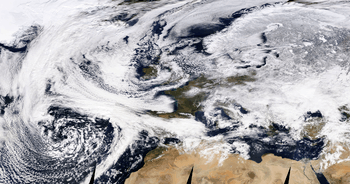Anticyclonic storm
An anticyclonic storm is a weather storm where winds around the storm flow in the direction opposite to that of the flow about a region of low pressure.
Description
In the Northern Hemisphere, anticyclonic storms involve clockwise wind flow; in the Southern Hemisphere, they involve counterclockwise wind flow.
Anticyclonic storms usually form around high-pressure systems. These do not "contradict" the Coriolis effect; it predicts such anticyclonic flow about high-pressure regions. Anticyclonic storms, as high-pressure systems, usually accompany cold weather and are frequently a factor in large snowstorms. Jupiter's Great Red Spot is a well-known non-terrestrial example of an anticyclonic system.
Anticyclonic tornadoes often occur;[1] while tornadoes' vortices are low-pressure regions, this occurs because tornadoes occur on a small enough scale such that the Coriolis effect is negligible.
Examples
- 25 February 2018 – 4 March: Hartmut, an exceptionally strong anticyclone whose winds peaked at 187 km/h (116 mph) and whose central pressure peaked at 1056 hPa, both in Scandinavia. This anticyclonic storm with hurricane-force maximum gusts channeled freezing air from a Siberian airmass all over Europe, triggering the Beast from the East, a deadly cold wave with historical significance. Having dropped large amounts of snow in some European areas, Hartmut was a rare instance of an "anticyclonic blizzard". The interaction of Anticyclone Hartmut and Cyclone Emma intensified the wind and snowfall threat in Western Europe, particularly on the British Isles.

References
- ↑ Williams, Jack. The Weather Book. New York: Vintage Books, 1992. Pages 118,122.
- ↑ https://worldview.earthdata.nasa.gov/?p=geographic&l=MODIS_Aqua_CorrectedReflectance_TrueColor(hidden),MODIS_Terra_CorrectedReflectance_TrueColor,Reference_Labels(hidden),Reference_Features(hidden),Coastlines(hidden)&t=2018-02-28&z=3&v=-53.07189015595597,10.555237522359441,59.42810984404403,65.82086252235945&ab=on&as=2018-02-20&ae=2018-02-27&av=3&al=false
External links
- https://www.sciencedaily.com/videos/2008/1108-jupiters_little_red_spot.htm Science Video: Jupiter's Little Red Spot Planetary Scientists Detect Strong Winds In Anticyclone On Jupiter. Article/video date: November 1, 2008.